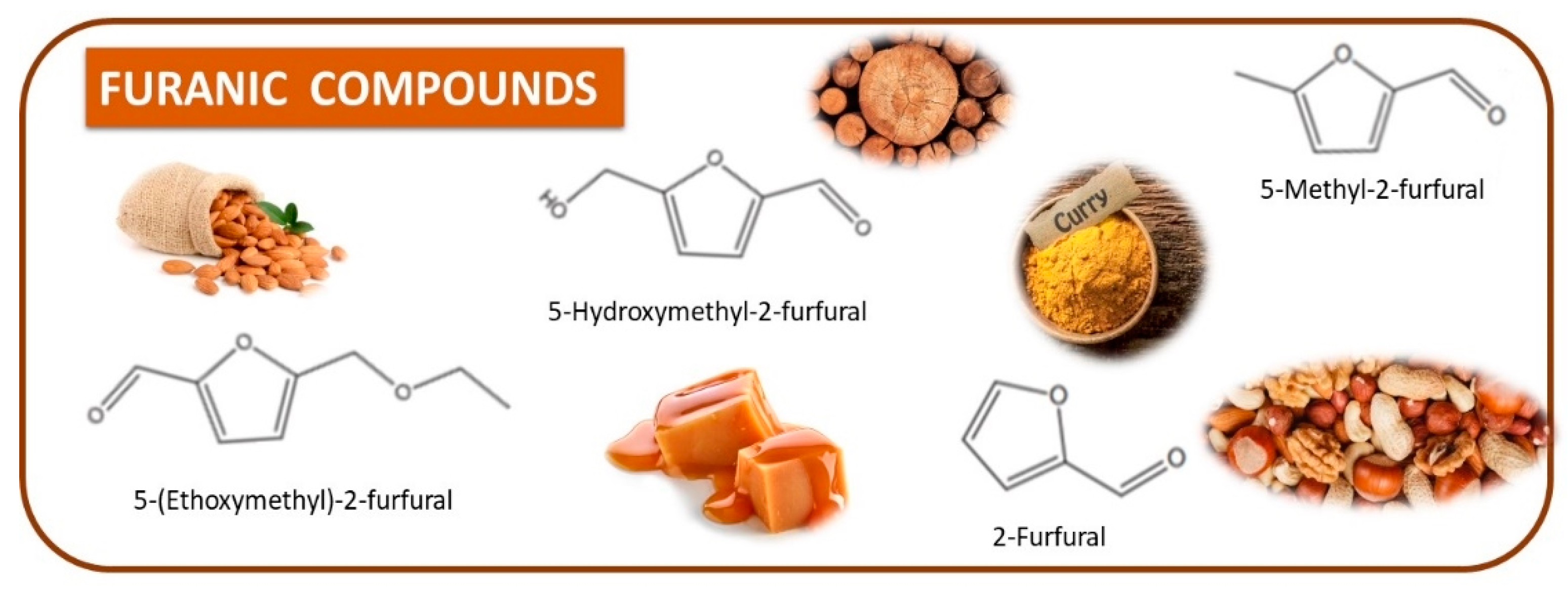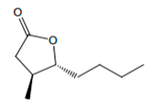The chemical fingerprint of fortified wines is very complex and fascinating, being constituted by several hundred volatile and non-volatile chemical groups, such as terpenoids, pyrazines, esters, alcohols, acids, furanic compounds, phenolic compounds, and organic acids, among others. These chemical groups were present in fortified wines at different volatilities, polarities, and concentration ranges, from a few ng/L to mg/L. However, the quality of wine also depends on several parameters, such as grape variety, vineyard location, terroir, and vinification conditions (e.g., fermentation, ageing), among others.
- fortified wines
- sui generis
- aroma descriptors
- winemaking process
1. Portuguese Fortified Wines

| VOMs | Structure | Odour Descriptor | OT (µg/L) |
|---|---|---|---|
| α-Terpeniol |  |
Warm peppery, mildly earthy, musty woody | 110 |
| Linalool |  |
Citrus, floral, fruity, green, muscat, sweet | 15 |
| β-Damascenone |  |
Sweet, exotic flowers, stewed apple | 4 |
| β-Ionone |  |
Violet, rose | 0.09 |
| Acetaldehyde | CH3CHO | Apple | 100 |
| 2-Nonenal isomer |  |
Green, fatty | 3 |
| Methional |  |
Cooked potato, cabbage | 0.5 |
| Phenylacetaldehyde |  |
Floral, honey | 1 |
| Sotolon |  |
Curry, seasoning | 8 |
| γ-Butyrolactone |  |
Caramel, sweet | - |
| cis-oak lactone |  |
Coconut | 25 |
| trans-oak lactone |  |
Coconut | 110 |
| 1,1-Diethoxyethane | CH3CH(OCH2CH3)2 | Green fruit | 1400 |
| Dioxolane and dioxane isomers |  |
Port-like, sweet | 100,000 |
2. Spanish Fortified Wines
3. Italian Fortified Wines
This entry is adapted from the peer-reviewed paper 10.3390/foods12132558
References
- Prata-Sena, M.; Castro-Carvalho, B.M.; Nunes, S.; Amaral, B.; Silva, P. The terroir of Port wine: Two hundred and sixty years of history. Food Chem. 2018, 257, 388–398.
- Martins, R.C.; Monforte, A.R.; Silva Ferreira, A. Port wine oxidation management: A multiparametric kinetic approach. J. Agric. Food. Chem. 2013, 61, 5371–5379.
- Camara, J.S.; Marques, J.C.; Alves, M.A.; Silva Ferreira, A.C. 3-Hydroxy-4,5-dimethyl-2(5H)-furanone levels in fortified Madeira wines: Relationship to sugar content. J. Agric. Food. Chem. 2004, 52, 6765–6769.
- Câmara, J.S.; Alves, M.A.; Marques, J.C. Changes in volatile composition of Madeira wines during their oxidative ageing. Anal. Chim. Acta 2006, 563, 188–197.
- Pereira, V.; Santos, M.; Cacho, J.; Marques, J.C. Assessment of the development of browning, antioxidant activity and volatile organic compounds in thermally processed sugar model wines. LWT 2017, 75, 719–726.
- Miranda, A.; Pereira, V.; Pontes, M.; Albuquerque, F.; Marques, J.C. Acetic acid and ethyl acetate in Madeira wines: Evolution with ageing and assessment of the odour rejection threshold. Ciência E Técnica Vitivinícola 2017, 32, 1–11.
- Perestrelo, R.; Silva, C.L.; Silva, P.; Câmara, J.S. Impact of storage time and temperature on volatomic signature of Tinta Negra wines by LLME/GC-ITMS. Food Res. Int. 2018, 109, 99–111.
- Pereira, V.; Leça, J.M.; Gaspar, J.M.; Pereira, A.C.; Marques, J.C. Rapid determination of sotolon in fortified wines using a miniaturized liquid-liquid extraction followed by LC-MS/MS analysis. J. Anal. Methods Chem. 2018, 2018, 4393040.
- Silva Ferreira, A.C.; Monteiro, J.; Oliveira, C.; Guedes de Pinho, P. Study of major aromatic compounds in port wines from carotenoid degradation. Food Chem. 2008, 110, 83–87.
- Oliveira e Silva, H.; de Pinho, P.G.; Machado, B.P.; Hogg, T.; Marques, J.C.; Camara, J.S.; Albuquerque, F.; Ferreira, A.C. Impact of forced-aging process on madeira wine flavor. J. Agric. Food. Chem. 2008, 56, 11989–11996.
- Perestrelo, R.; Nogueira, J.M.F.; Câmara, J.S. Potentialities of two solventless extraction approaches-Stir bar sorptive extraction and headspace solid-phase microextraction for determination of higher alcohol acetates, isoamyl esters and ethyl esters in wines. Talanta 2009, 80, 622–630.
- Pereira, A.C.; Reis, M.S.; Saraiva, P.M.; Marques, J.C. Analysis and assessment of Madeira wine ageing over an extended time period through GC-MS and chemometric analysis. Anal. Chim. Acta 2010, 660, 8–21.
- Perestrelo, R.; Barros, A.S.S.; Câmara, J.S.S.; Rocha, S.M.M. In-depth search focused on furans, lactones, volatile phenols, and acetals as potential age markers of Madeira wines by comprehensive two-dimensional gas chromatography with time-of-flight mass spectrometry combined with solid phase microextraction. J. Agric. Food. Chem. 2011, 59, 3186–3204.
- Pereira, V.; Cacho, J.; Marques, J.C. Volatile profile of Madeira wines submitted to traditional accelerated ageing. Food Chem. 2014, 162, 122–134.
- Oliveira, C.M.; Santos, S.A.O.; Silvestre, A.J.D.; Barros, A.S.; Ferreira, A.C.S.; Silva, A.M.S. Quantification of 3-deoxyglucosone (3DG) as an aging marker in natural and forced aged wines. J. Food Compos. Anal. 2016, 50, 70–76.
- Campo, E.; Ferreira, V.; Escudero, A.; Marqués, J.C.; Cacho, J. Quantitative gas chromatography-olfactometry and chemical quantitative study of the aroma of four Madeira wines. Anal. Chim. Acta 2006, 563, 180–187.
- Culleré, L.; Cacho, J.; Ferreira, V. An assessment of the role played by some oxidation-related aldehydes in wine aroma. J. Agric. Food. Chem. 2007, 55, 876–881.
- Zea, L.; Serratosa, M.P.; Mérida, J.; Moyano, L. Acetaldehyde as Key Compound for the Authenticity of Sherry Wines: A Study Covering 5 Decades. Compr. Rev. Food Sci. Food Saf. 2015, 14, 681–693.
- Martínez, P.; Pérez Rodríguez, L.; Benítez, T. Evolution of Flor Yeast Population During the Biological Aging of Fino Sherry Wine. Am. J. Enol. Vitic. 1997, 48, 160–168.
- Zea, L.; Serratosa, M.P.; Monforte, A.; Ferreira, A.C.S. Fortified wines. In Managing Wine Quality: Volume 2: Oenology and Wine Quality; Elsevier: Amsterdam, Netherlands, 2021; pp. 629–668.
- Moreno, J.A.; Zea, L.; Moyano, L.; Medina, M. Aroma compounds as markers of the changes in sherry wines subjected to biological ageing. Food Control 2005, 16, 333–338.
- Pe, L.J.; Rez-Prieto, Ä.; Lo Ä Pez-Roca, J.M.; Marti Änez-Cutillas, A.; Pardo, F.; Änguez, M.I.; Go, E.; Mez-Plaza, Ä. Maturing Wines in Oak Barrels. Effects of Origin, Volume, and Age of the Barrel on the Wine Volatile Composition. J. Agric. Food Chem. 2002, 50, 3272–3276.
- Herrera, P.; Durán-Guerrero, E.; Sánchez-Guillén, M.M.; García-Moreno, M.V.; Guillén, D.A.; Barroso, C.G.; Castro, R. Effect of the type of wood used for ageing on the volatile composition of Pedro Ximénez sweet wine. J. Sci. Food Agric. 2020, 100, 2512–2521.
- Muñoz, D.; Peinado, R.A.; Medina, M.; Moreno, J. Higher alcohols concentration and its relation with the biological aging evolution. Eur. Food Res. Technol. 2006, 222, 629–635.
- Fernández De Simón, B.; Cadahía, E.; Jalocha, J. Volatile Compounds in a Spanish Red Wine Aged in Barrels Made of Spanish, French, and American Oak Wood. J. Agric. Food. Chem. 2003, 51, 7671–7678.
- Zea, L.; Moyano, L.; Moreno, J.; Cortes, B.; Medina, M. Discrimination of the aroma fraction of Sherry wines obtained by oxidative and biological ageing. Food Chem. 2001, 75, 79–84.
- Moyano, L.; Zea, L.; Moreno, J.; Medina, M. Analytical study of aromatic series in sherry wines subjected to biological aging. J. Agric. Food. Chem. 2002, 50, 7356–7361.
- Zea, L.; Moyano, L.; Moreno, J.A.; Medina, M. Aroma series as fingerprints for biological ageing in fino sherry-type wines. J. Sci. Food Agric. 2007, 87, 2319–2326.
- Zea, L.; Moyano, L.; Ruiz, M.J.; Medina, M. Chromatography-Olfactometry Study of the Aroma of Fino Sherry Wines. Int. J. Anal. Chem. 2010, 2010, 626298.
- Moyano, L.; Zea, L.; Moreno, J.A.; Medina, M. Evaluation of the active odorants in Amontillado sherry wines during the aging process. J. Agric. Food. Chem. 2010, 58, 6900–6904.
- Zea, L.; Moyano, L.; Ruiz, M.J.; Medina, M. Odor Descriptors and Aromatic Series During the Oxidative Aging of Oloroso Sherry Wines. Int. J. Food Prop. 2013, 16, 1534–1542.
- García-Moreno, M.V.; Sánchez-Guillén, M.M.; Delgado-González, M.J.; Durán-Guerrero, E.; Rodríguez-Dodero, M.C.; García-Barroso, C.; Guillén-Sánchez, D.A. Chemical content and sensory changes of Oloroso Sherry wine when aged with four different wood types. LWT 2021, 140, 110706.
- Dugo, G.; Franchina, F.A.; Scandinaro, M.R.; Bonaccorsi, I.; Cicero, N.; Tranchida, P.Q.; Mondello, L. Elucidation of the volatile composition of Marsala wines by using comprehensive two-dimensional gas chromatography. Food Chem. 2014, 142, 262–268.
- Condurso, C.; Cincotta, F.; Tripodi, G.; Verzera, A. Characterization and ageing monitoring of Marsala dessert wines by a rapid FTIR-ATR method coupled with multivariate analysis. Eur. Food Res. Technol. 2018, 244, 1073–1081.
- Petretto, G.; Urgeghe, P.P.; Cabizza, R.; Del Caro, A. Evaluation of volatile and chemical profile of sherry-like white wine Vernaccia di Oristano from Sardinia by comprehensive targeted and untargeted approach. Eur. Food Res. Technol. 2023, 249, 1887–1897.
- Alexandre, H. Flor yeasts of Saccharomyces cerevisiae—Their ecology, genetics and metabolism. Int. J. Food Microbiol. 2013, 167, 269–275.
- Muratore, G.; Asmundo, C.; Lanza, C.; Caggia, C.; Licciardello, F.; Restuccia, C. Influence of Saccharomyces uvarum on Volatile Acidity, Aromatic and Sensory Profile of Malvasia delle Lipari Wine. Food Technol. Biotechnol. 2007, 45, 101–106.
- Arena, E.; Rizzo, V.; Licciardello, F.; Fallico, B.; Muratore, G. Effects of Light Exposure, Bottle Colour and Storage Temperature on the Quality of Malvasia delle Lipari Sweet Wine. Foods 2021, 10, 1881.
